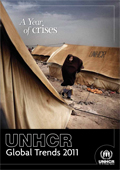 The UNHCR Global Trends 2014 Report released earlier this week by the UN High Commissioner for Refugees finds that “wars, conflict and persecution have forced more people than at any other time since records began to flee their homes and seek refuge and safety elsewhere“.
The UNHCR Global Trends 2014 Report released earlier this week by the UN High Commissioner for Refugees finds that “wars, conflict and persecution have forced more people than at any other time since records began to flee their homes and seek refuge and safety elsewhere“.
Commemorating World Refugee Day, UN High Commissioner for Refugees António Guterres declared in a statement that “around the world, almost 60 million have been displaced by conflict and persecution. Nearly 20 million of them are refugees, and more than half are children. Their numbers are growing and accelerating, every single day, on every continent.” But while the ‘western’ media takes an often embarrassingly western-centric view, and European politicians struggling to find solutions to this global crisis, the report also shows how big this human crisis really has become.
The following two cartograms show the most recent picture of global refugee trends in 2014 as published in the 2015 UNHCR report. The two maps use the total numbers for ‘refugees and people in refugee-like situations’ according to their country of origin and destination and resizes each country according to its absolute number of refugees. Excluded in these maps are those refugees whose origin is unknown or who are stateless or cannot be assigned to a specific country:
Tag Archives: refuguee
A year of crises: Global refugee trends
 “A report released by the UN High Commissioner for Refugees shows 2011 to have been a record year for forced displacement across borders, with more people becoming refugees than at any time since 2000. UNHCR’s ‘Global Trends 2011’ report details for the first time the extent of forced displacement from a string of major humanitarian crises that began in late 2010 in Côte d’Ivoire, and was quickly followed by others in Libya, Somalia, Sudan and elsewhere. In all, 4.3 million people were newly displaced, with a full 800,000 of these fleeing their countries and becoming refugees.” (Quoted from the UNHCR Press Release)
“A report released by the UN High Commissioner for Refugees shows 2011 to have been a record year for forced displacement across borders, with more people becoming refugees than at any time since 2000. UNHCR’s ‘Global Trends 2011’ report details for the first time the extent of forced displacement from a string of major humanitarian crises that began in late 2010 in Côte d’Ivoire, and was quickly followed by others in Libya, Somalia, Sudan and elsewhere. In all, 4.3 million people were newly displaced, with a full 800,000 of these fleeing their countries and becoming refugees.” (Quoted from the UNHCR Press Release)
In the Worldmapper project we have mapped refugees before (see the maps of refugee origins and destinations) but these maps are far more outdated than most material that we have on Worldmapper. Not only provides the new report a comprehensive updated series of data, but also are refugee numbers of an extremely changing nature as they do not follow general mid- or long-term trends (such as changes in population or carbon emissions). As the introductory statement indicates, humanitarian crises and other hardly predictable events can result in changing refugee patterns.
The following two maps show the updated picture of refugee trends in 2011 as published in the UNHCR report this week (which also saw the commemoration of World Refugee Day “dedicated to raising awareness of the situation of refugees throughout the world“. The two maps use the total numbers for ‘refugees and people in refugee-like situations’ according to their country of origin and destination. Excluded in these maps are those refugees whose origin is unknown or who are stateless:


